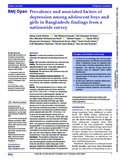| dc.contributor.author | Mridha, Malay Kanti | |
| dc.contributor.author | Hossain, Md Mokbul | |
| dc.contributor.author | Khan, Md Showkat Ali | |
| dc.contributor.author | Hanif, Abu Abdullah Mohammad | |
| dc.contributor.author | Hasan, Mehedi | |
| dc.contributor.author | Mitra, Dipak | |
| dc.contributor.author | Hossaine, Moyazzam | |
| dc.contributor.author | Ullah, Mohammad Aman | |
| dc.contributor.author | Sarker, Samir Kanti | |
| dc.contributor.author | Rahman, S M Mustafizur | |
| dc.contributor.author | Bulbul, Md M Islam | |
| dc.contributor.author | Shamim, Abu Ahmed | |
| dc.date.accessioned | 2022-06-14T04:11:40Z | |
| dc.date.available | 2022-06-14T04:11:40Z | |
| dc.date.copyright | 2021 | |
| dc.date.issued | 2021-01-17 | |
| dc.identifier.citation | Mridha, M. K., Hossain, M. M., Khan, M. S. A., Hanif, A. A. M., Hasan, M., Mitra, D., . . . Shamim, A. A. (2021). Prevalence and associated factors of depression among adolescent boys and girls in Bangladesh: Findings from a nationwide survey. BMJ Open, 11(1) doi:10.1136/bmjopen-2020-038954 | en_US |
| dc.identifier.uri | http://hdl.handle.net/10361/16979 | |
| dc.description | This article was published in BMJ Open by BMJ Journals [© Author(s) (or their employer(s)) 2021. Re-use permitted under CC BY-NC. No commercial re-use. See rights and permissions. Published by BMJ.] and the definite version is available at: http://dx.doi.org/10.1136/bmjopen-2020-038954 The Journal's website is at: https://bmjopen.bmj.com/content/11/1/e038954 | en_US |
| dc.description.abstract | Objective: To assess the prevalence of and factors
associated with depression among adolescent boys and
girls.
Design: We conducted a nationwide cross-sectional study.
Setting: This study was carried out in 82 randomly
selected clusters (57 rural, 15 non-slum urban and 10
slums) from eight divisions of Bangladesh.
Participants: We interviewed 4907 adolescent boys and
4949 adolescent girls.
Primary and secondary outcome measures The
primary outcome measure was ‘any depression’ and the
secondary outcome measures were types of depression:
no or minimal, mild, moderate, moderately severe and
severe.
Results: The overall prevalence of no or minimal, mild,
moderate, moderately severe and severe depression
was 75.5%, 17.9%, 5,4%, 1.1% and 0.1%, respectively.
Across most of the sociodemographic, lifestyle and
anthropometric strata, the prevalence of any depression
was higher among adolescent girls. In both sexes,
depression was associated with higher age, higher
maternal education, paternal occupation e.g., business,
absence of a 6–9-year-old member in the household,
food insecurity, household consumption of unfortified oil,
household use of non-iodised salt, insufficient physical
activity (adjusted odds ratio, AOR: 1.24 for boys, 1.44
for girls) and increased television viewing time e.g.,
≥121minute/day (AOR: 1.95 for boys, 1.99 for girls). Only
among boys, depression was also associated with higher
paternal education e.g., complete secondary and above
(AOR: 1.42), absence of another adolescent member in the
household (AOR: 1.34), household use of solid biomass fuel
(AOR: 1.39), use of any tobacco products (AOR: 2.17), and
consumption of processed food (AOR: 1.24). Only among
girls, non-slum urban residence, Muslim religion, and
household size ≤4 were also associated with depression.
Conclusion: The prevalence of depression among
adolescent boys and girls is high in Bangladesh. In
most sociodemographic, lifestyle and anthropometric
strata, the prevalence is higher among girls. In this
age group, depression is associated with a number of
sociodemographic and lyfestyle factors. The government
of Bangladesh should consider these findings while
integrating adolescent mental health in the existing and
future programmes. | en_US |
| dc.language.iso | en_US | en_US |
| dc.publisher | BMJ Journals | en_US |
| dc.relation.uri | https://bmjopen.bmj.com/content/11/1/e038954 | |
| dc.subject | Depression | en_US |
| dc.subject | Factors of depression | en_US |
| dc.subject | Adolescent boys and girls | en_US |
| dc.subject | Findings | en_US |
| dc.subject | Nationwide survey | en_US |
| dc.title | Prevalence and associated factors of depression among adolescent boys and girls in Bangladesh: Findings from a nationwide survey | en_US |
| dc.type | Journal Article | en_US |
| dc.description.version | Published | |
| dc.contributor.department | Brac James P. Grant School of Public Health | |
| dc.identifier.doi | http://dx.doi.org/10.1136/bmjopen-2020-038954 | |
| dc.relation.journal | BMJ Open | |

